Checkpoint Exam: Conditional Forwarding and Route Redistribution Exam Answers
Modules 15 – 17 of the CCNP Enterprise: Advanced Routing v8.0 (ENARSI)
1. Which three statements describe ACL processing of packets? (Choose three.)
- Each packet is compared to the conditions of every statement in the ACL before a forwarding decision is made.
- A packet can either be rejected or forwarded as directed by the statement that is matched.
- A packet that does not match the conditions of any ACL statements will be forwarded by default.
- An implicit deny any rejects any packet that does not match any ACL statement.
- A packet that has been denied by one statement can be permitted by a subsequent statement.
- Each statement is checked only until a match is detected or until the end of the ACL statement list is reached.
2. Which two network prefixes match the prefix match pattern 10.168.0.0/13 ge 24? (Choose two.)
- 10.104.0.0/24
- 10.168.0.0/24
- 10.173.1.0/28
- 10.168.1.0/22
- 10.168.0.0/13
3. Refer to the exhibit. Based on the information that is presented, which statement is true?
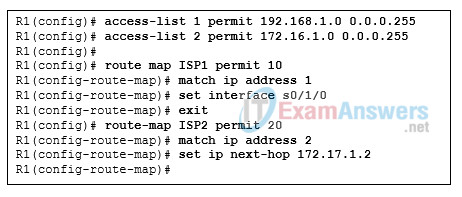
- Packets that match access list 1 will be sent to the next-hop address 172.17.1.2.
- Both match statements must be true for the ISP1 route map to be true.
- Access list 1 specifies that packets with a destination address of 192.168.1.0 will be policy routed.
- Access list 2 specifies that packets with a source address of 172.16.1.0 will be policy routed.
- Packets that match access list 2 will be denied access.
4. Which prefix would match the prefix list ip prefix-list NAME seq 5 permit 10.0.0.0/8 ge 22 le 26 ?
- 10.0.0.0/8
- 10.0.0.0/30
- 10.0.0.0/24
- 10.0.0.0/16
5. What are two operational characteristics of policy based routing? (Choose two.)
- Next-hop addresses defined in PBR set statements are placed in the routing table.
- PBR examines packets as they exit a router interface.
- PBR performs conditional forwarding based only on source or destination IP address.
- Local PBR policies can identify packets that originate from a router.
- PBR can be configured to forward packets to next-hop addresses that are not in the routing table.
6. Refer to the exhibit. Where would the system administrator apply the following configuration to establish policy-based routing that directs packets from the 10.0.0.0/8 network through the R2 router to the Internet?
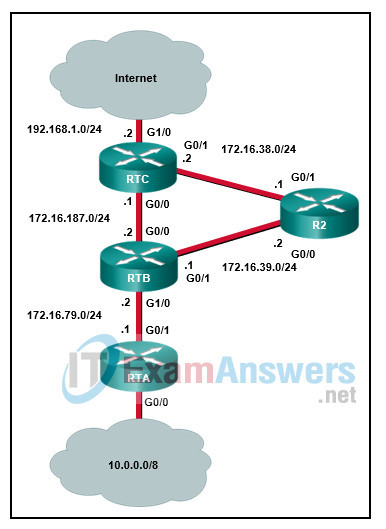
access-list 111 permit ip 10.0.0.0 0.255.255.255 any route-map net-10 permit 10 match ip address 111 set interface gigabitethernet 0/1
- RTA interface G0/0
- RTB interface G1/0
- R2 interface G0/0
- RTA interface G0/1
- R2 interface G0/1
- RTB interface G0/1
7. Which rule applies to route map statements?
- Sequence numbers increment by 5 automatically if not provided.
- After a matching criterion, processing continues until all match criteria are checked.
- Boolean logic “and” is used if multiple variables are configured for a specific route map sequence.
- A default value of permit is used if there is no processing action defined.
8. What is the default auto-increment sequence number value of a route map if none is specified?
- 1
- 5
- 10
- 50
9. Refer to the exhibit. Two-way redistribution was configured between OSPF and EIGRP on R2. After the redistribution, R3 does not see any external routes coming from the EIGRP domain. The debug ip ospf database external output reveals that no external LSAs are generated for the routes. What could be the problem?
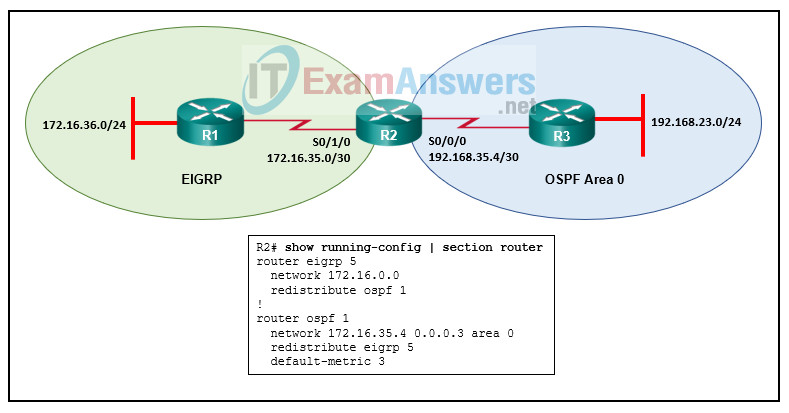
- A default-metric command is missing from the EIGRP configuration.
- A distribute list is needed for both OSPF and EIGRP.
- An area 0 stub command is missing from the OSPF configuration.
- A subnet keyword is missing from the OSPF configuration.
10. Refer to the exhibit. How will seed metrics be applied to routes redistributed into EIGRP?

- A seed metric of 0 is set for redistributed RIP routes into EIGRP.
- RIP routes are redistributed into EIGRP with a seed metric of infinity.
- Both RIP and OSPF will be redistributed into EIGRP with the same seed metric.
- OSPF is redistributed into EIGRP with a seed metric of 1.
11. Based on the configuration shown, what code will appear in the routing table for redistributed routes on the router?
router ospf 1 router-id 1.1.1.1 network 10.23.1.0 0.0.0.255 area 0 redistribute eigrp 100 subnets metric-type 1
- O E2
- O IA
- O E1
- D EX
12. What default weight metric is used by BGP for routes redistributed from an IGP?
- 32768
- 16384
- 8192
- 4096
13. Which two statements describe default redistribution behavior? (Choose two.)
- Redistributed routes must exist in the RIB.
- BGP only redistributes IBGP routes into an IGP protocol.
- Redistribution is transitive between protocols when configured on a single router.
- Sequential protocol redistribution occurs between multiple routing protocols over a series of routers.
- The seed metric for redistributed routes is the same for all IGP protocols.
14. Refer to the exhibit. Which three network redistribution actions will take place on router R1? (Choose three.)
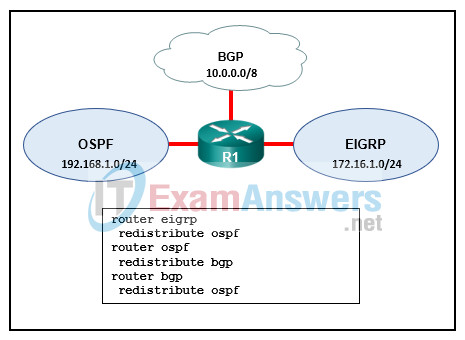
- The OSPF route 192.168.1.0 is redistributed into BGP.
- The OSPF route 192.168.1.0/24 is redistributed into EIGRP.
- The EIGRP route 172.16.1.0/24 is redistributed into OSPF.
- The EIGRP route 172.16.1.0/24 is redistributed into BGP.
- The BGP route 10.0.0.0/8 is redistributed into OSPF.
- The BGP route 10.0.0.0/8 is redistributed into EIGRP.
15. Refer to the exhibit. What metric will RIP routes have when redistributed into EIGRP?

- K values of 1000 100 255 1 1500
- infinity
- zero
- 100
16. Which two are characteristics of routes redistributed into EIGRP? (Choose two.)
- The administrative distance is 200.
- The administrative distance is 170.
- The default seed metric is infinity.
- The default seed metric is 1.
- The default seed metric is 20.
- The administrative distance is 90.
17. Which characteristic describes an OSPF type 2 external route?
- It is preferred over type 1 external routes.
- It is the default external route type used by OSPF.
- It has a default seed metric of 20 for routes redistributed from BGP.
- It has a metric that equals the redistribution metric plus the total path metric.
18. Refer to the exhibit. What redistribution will result from the configuration on R1?
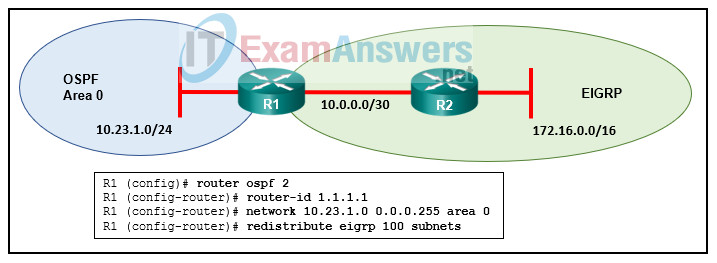
- Network 172.16.0.0/16 is redistributed into OSPF as a type 1 route with a seed metric of 1.
- Network 10.23.1.0/24 is redistributed into EIGRP as an external route with a seed metric of infinity.
- Network 172.16.0.0/16 is redistributed into OSPF as a type 2 route with a seed metric of 20.
- Network 10.23.1.0/24 is redistributed into EIGRP as an external route with a seed metric of 100.
19. What two pieces of information are lost when redistributing routes from one routing source into another routing source and injecting a seed metric at the point of redistribution? (Choose two.)
- classless networks
- routing source information
- classful networks
- network visibility
- route tags
20. After the implementation of redistribution on a boundary router, a resource connected to a network consisting of varying link speeds is having a delayed response to user connectivity. What issue might exist?
- Classless route entries may exist.
- Routing loops may exist.
- Incomplete routing tables may exist.
- Suboptimal routing may exist.
- Classful route entries may exist.
21. Refer to the exhibit. A network engineer has issued the verification command while troubleshooting a routing loop on the network. What is the error in the configuration?
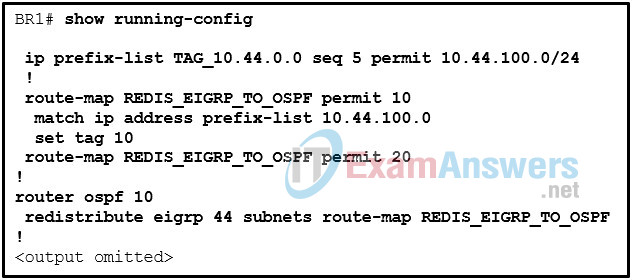
- The route-map is dropping all other routes that do not match the prefix list TAG_10.44.100.0.
- The match ip address command refers to the incorrect prefix list.
- The redistribute command is configured to filter routes using the route map instead of the prefix list.
- The route-map sequence 20 is missing the match and set statements.
22. While configuring a boundary router that utilizes OSPF and BGP, a network engineer performs redistribution without modifying source or destination metrics. What default value is the engineer using for successful redistribution?
- default administrative distance
- default classful redistribution
- default seed metric
- default classless redistribution
23. Refer to the exhibit. A network engineer has issued the commands shown on a boundary router. What is the result of this command?

- The EIGRP AS 90 process has been configured to redistribute RIP routes.
- The internal administrative distance for EIGRP AS 90 has been changed to 120.
- The external administrative distance for EIGRP AS 90 has been changed to 120.
- The default seed metric for EIGRP AS 90 has been changed to 120.
24. Refer to the exhibit. A junior administrator issues the show ip protocol command while troubleshooting missing NSSA OSPF routes. What is the most likely cause for the missing OSPF routes?
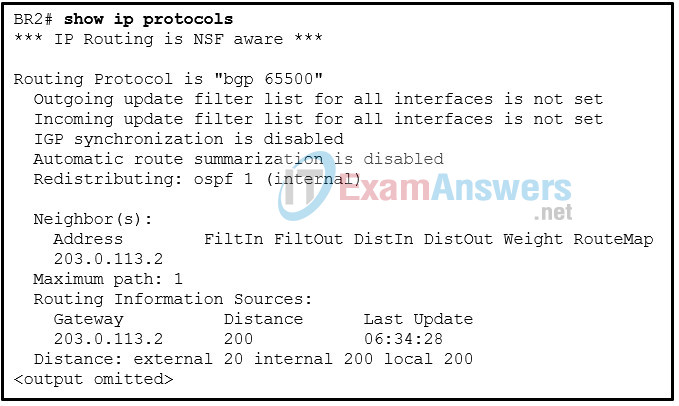
- The BGP configuration is not using automatic summarization.
- The BGP configuration is configured for IBGP instead of EBGP.
- The redistribute command is not issued with a match keyword.
- The redistribute command is not issued with a metric keyword.
25. A network engineer has issued the following configuration commands:
router ospf 1 router-id 200.200.200.200 distance ospf intra-area 101 inter-area 104 external 122 network 10.44.11.0 0.0.0.255 area 0 redistribute eigrp 100 metric-type 1
What outcome is expected from the commands issued?
- The redistributed routes will be tagged by the numeric router-id of 200.200.200.200.
- Any OSPF routes to the same destination network will be preferred over the redistributed EIGRP routes because of the modification of OSPF AD values.
- As EIGRP routes are redistributed, the configured metric-type will cause the seed metric to be preserved at the point of redistribution.
- The classless EIGRP networks will be left out of the redistribution process and only the classful networks will be redistributed.
26. A boundary router is performing mutual redistribution between OSPF and EIGRP. What process should be taken to have an external EIGRP route preferred over an OSPF route to the same destination network?
- Modify the administrative distance parameter for the external EIGRP routes to be set to 100.
- Modify the default seed metric to 21 for the source information from OSPF.
- Modify the administrative distance parameter for the internal EIGRP routes to be set to 180.
- Modify the default seed metric to 19 for the source information from OSPF.
27. An IPv6 network topology using redistribution is experiencing reachability issues after migrating from an IPv4 deployment. How is the deployment of IPv6 redistribution different from what it is with IPv4?
- The local interfaces participating in the source routing protocol are not redistributed unless the include-connected command is issued.
- The metric keyword is not required in redistributing OSPFv3 into EIGRPv6.
- The classless networks of a source routing protocol will only be redistributed with the use of the match keyword.
- The deployment of an IPv6 redistribution process does not support the implementation of route maps.
28. If multiple seed metrics are defined with redistribution, which metric would be preferred over others?
- a metric defined in the routing protocol message from the source protocol
- a metric defined in a route map that was applied to the redistribute command
- a metric defined in the redistribute command
- a metric defined using the default-metric command
29. Which two statements describe default behaviors of route redistribution? (Choose two.)
- Routes redistributed into OSPF from BGP have a seed metric of 1.
- Routes redistributed into OSPF have an AD of 20.
- Routes redistributed into EIGRP have an AD of 190.
- The BGP weight for redistributed routes is 4096.
- BGP only redistributes EBGP routes into IGP protocols.
30. What is the default OSPF seed metric for routes redistributed from BGP?
- 1
- 10
- 20
- infinity
31. A network engineer has issued the show run | section router eigrp command. What outcome is expected from the command output?
R1# show run | section router eigrp router eigrp 99 network 172.21.33.1 0.0.0.0 redistribute ospf 1 ipv6 router eigrp 99 redistribute ospf 1 metric 100000 100 255 1 1500 include-connected
- The EIGRP for IPv4 configuration will not redistribute OSPF routes without a match keyword.
- The EIGRP for IPv6 configuration will not redistribute OSPF routes without a match keyword.
- The EIGRP for IPv4 configuration will not redistribute OSPF routes without the include-connected keyword.
- The EIGRP for IPv4 configuration will not redistribute OSPF routes without the metric keyword.
32. A network engineer has issued the following configuration commands:
router ospf 10 router-id 10.10.10.10 distance ospf intra-area 105 inter-area 107 external 144 network 10.44.11.0 0.0.0.255 area 0 router bgp 65001 address-family ipv6 unicast redistribute ospf 10
What outcome is expected from the commands issued?
- The internal routes in the OSPF process are redistributed into the BGP protocol and the external OSPF routes are not included.
- The BGP protocol is unable to process the redistributed OSPF routes unless a metric is defined.
- The configuration is missing a route map in order to match the OSPF routes that require redistribution.
- The local interfaces participating in the OSPF process are redistributed into the BGP protocol.

3. Refer to the exhibit. Based on the information that is presented, which statement is true?
I guess the correct answer is
Sorry, you are wrong. Standard access-lists refer always to the source ip and therefore it will never be the destination ip which is compared
is this stuff still valid coz I m giving exam tomorrow
your reply will be much appreciated. Thankyou
2. Which two network prefixes match the prefix match pattern 10.168.0.0/13 ge 24? (Choose two.)
Sorry, but you are wrong:
Because the network part says 13 bits you have to use those. And because the bits 9, 11 and 13 are set the minimum IP will be 10.168. and 10.173. can be set with additional bits 14 and 16.
10.168.0.0/13
9 10 11 12 13 14 15 16 <– bits of 2nd octet
128 64 32 16 8 4 2 1
1 0 1 0 1 0 0 0 <– 168 translated into binary
So you have the second part where it states that the subnet mask has to be greater or equal to 24 –> therefore a mask of 22 is not possible.
The original answer is correct and your answer is wrong
10.168 ~ 175.x.x is match
Hi, Question 32 is quite confusing to me. There is OSPF process 10 (ospfv2 for ipv4) in the configuration and the same ospf is “redistributed” under ipv6 adress-family section of BGP 65001. I guess, that answer should be “This configuration of redistribution is invalid” :)
Is this 300-410 valid?
Here: https://itexamanswers.net/ccnp-enarsi-300-410-dumps-full-questions-with-vce-pdf.html